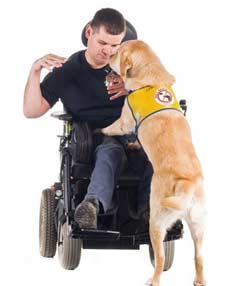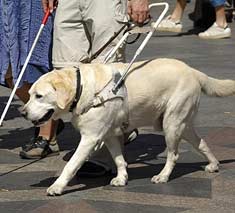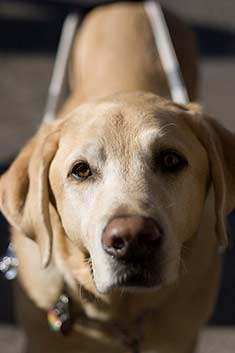Service Dogs
What is a service dog?
As defined by the Americans with Disabilities Act (ADA) of 1990, a service animal is “any guide dog, signal dog, or other animal that is individually trained to do work or perform tasks for the benefit of an individual with a disability, including, but not limited to, guiding people with impaired vision, alerting people with impaired hearing to intruders or sounds, providing minimal protection or rescue work, pulling a wheelchair, or fetching dropped items.”
That’s a mouthful! The essence of the definition is that a service dog helps a differently- abled person cope with everyday life. Most of us are familiar with guide dogs for the blind, as they are commonly seen leading their humans across streets. They are easily identified by their specialty harnesses and by the white cane typically carried by the visually impaired.

However, what you might not have thought about is that assistance dogs can help people with a wide range of impairments. As implied by the definition from the ADA, service dogs may help the hearing impaired by alerting them to the presence of dangers such as intruders or they may help those in wheelchairs by providing mobility or picking up dropped items. Remarkably, some dogs can even sense when a person is about to have a seizure and will back the person into a corner where they can safely fall, sliding down the walls when the seizure occurs.
For those with strength problems such as people suffering from muscle wasting diseases, service dogs can provide invaluable support to allow the person to continue to live his life independently. Such dogs may be trained to open refrigerator doors and cabinets or even to push the button which opens a handicapped-accessible entry door.
How are service dogs trained?
Some people who acquire a service dog are able to train the dog themselves, simply using rewards to teach the dog to do the unique tasks with which that particular person needs help. This type of training is accomplished in the same way you might teach your dog basic obedience like “sit”, “stay”, “heel”, or “come.”
After selecting an appropriate dog from a breeder or shelter, the person simply sets about to train the dog for his specific needs. This is commonly done by a person who has a progressive illness rather than by one who is already totally disabled. As the disease progresses, the dog simply learns new tricks to continue to aid the person as his abilities diminish.
Far more common, however, are the training programs developed for dogs to serve people with specific needs. For example, the Lions Foundation of Canada was founded specifically to train dogs to assist the visually impaired. The dogs there are taught the skills that any blind person is likely to need such as guidance in negotiating city streets. The Lions Foundation has since expanded their reach to include training dogs for people with different types of disabilities such as hearing and physical impairments. More information on this program is available here.
Another program, Paws With A Cause, was originally founded as “Ears for the Deaf”, specializing in dogs who assisted those with hearing impairments. This program, located in Michigan, has since expanded to include mobility assistance and seizure response dogs.
Several other assistance dog programs exist in North America. A partial list, along with their websites, is shown below:
- Support Dogs, Inc., based in St. Louis, MO: www.supportdogs.org
- Canine Companions for Independence, founded in Santa Rosa, CA and now operating in five national regions: www.caninecompanions.org
- Dogs for Diabetics, Inc.: www.dogs4diabetics.com
- The Mira Foundation in Quebec: www.mira.ca
- The Delta Society: www.deltasociety.org

Describe the life of a service dog
A typical assistance dog starts out his life as any other puppy, either at a breeder’s home or at a shelter or rescue facility. Dogs are selected for participation in a service dog program partly by virtue of breed, with Golden Retrievers, Labrador Retrievers, and Huskies being quite common, and partly by virtue of the characteristic traits they display. An assistance dog needs to demonstrate intelligence, emotional stability, an interest in pleasing humans, self-confidence, and a total lack of aggression.
Puppies who demonstrate the proper traits are selected and are usually placed with foster families for about a year. In the foster home, the puppies are socialized to be comfortable with all ages of people as well as with other animals. Foster families teach the dog basic obedience commands and make special efforts to expose them to loud noises, crowds, and other situations which could potentially upset the dog.
At the end of the first year, the dog is again evaluated to see if he meets the qualifications each particular training facility has set based on their experience with previous candidates. If the dog doesn’t pass this screening, he may be offered to the foster family or put up for adoption. Dogs who do qualify are generally placed with one of the facility’s trainers for full time skill-building.
Depending on the type of assistance the dog is expected to give, the trainer works with the dog to develop skills such as turning on lights, opening doors, finding lost objects, or alerting the human to a ringing telephone or doorbell. The length of this training is dependent on the number of skills to be learned, as well as on the dog’s abilities.
Once this training is completed, the dog is then matched with a person who needs his particular skills, and the two are shown how to work together. The dog goes to live with the person, providing day-to-day assistance for various tasks. Although he may look just like a pet, an assistance dog has a very specialized job to do and should not be approached on the street when he is working.
The typical service dog’s working life is about 10 years, at which time he is retired. He may stay with the human he is currently assisting or may be placed with another family for the remainder of his natural life.

How do I know when an assistance dog is at work?
Most assistance dogs wear some sort of vest denoting their special status. The vest may say “assistance dog” or “assistance dog in training”. In either case, they should not be approached or petted without permission from the handler. The dog typically recognizes that when he is dressed in his uniform, he is at work. He will not generally be interested in seeing what you have to offer, unless it is early in his training.
Where can assistance dogs go?
Service dogs are allowed to go anywhere their humans go: airplane passenger compartments, restaurants, parks where other animals are not permitted, etc. Under no circumstances may a service dog be excluded from entry into any place where people are allowed.
In addition, the handler may not be required to do anything special in order to bring his dog with him. For example, he cannot be made to pay an additional security deposit when renting an apartment. The handler is responsible, however, for any damage the dog does to a place where he is taken.
Most service dogs are trained to stay quiet, minimizing their disruption to other people in the area. In fact, many of these dogs tend to blend into their environments so much that others don’t even notice the dog is there until he walks his owner outside the establishment.
Many business owners do not recognize the rights of the disabled to bring their service animals with them wherever they go. Humans who are not visually impaired report an especially difficult time in getting recognition of their rights regarding assistance dogs.
If you have a service dog and have experienced discrimination, here are some places you can turn for help:
- For access to public places, contact the Department of Justice
- 800-514-0301, TTY: 800-514-0383
- www.usdoj.gov/crt/ada/adahom1.htm
- For housing, contact the Department of Housing and Urban Development
- 202-708-1112, TTY: 202-708-1455
- www.hud.gov
- For travel, contact the Department of Transportation
- 202-366-4000
- www.dot.gov
- To take your dog to work, contact the Job Accommodation Network of the Department of Labor
- 800-526-7234
- www.janweb.icdi.wvu.edu
- For international travel, contact Assistance Dogs International
- www.adionline.org, where you can purchase the book Assistance Dogs International’s Guide to Assistance Dog Laws
- For laws specific to your state, contact your state’s Attorney General.

How much does it cost to place a service dog with a differently-abled person?
Costs vary widely depending on the amount of training the dog needs for a particular situation, as well as where the dog was originally purchased, and whether or not the dog is self-trained or program-trained.
For example, a dog picked up at the pound and trained by the individual for his own specific needs may cost no more than a dog purchased as a pet. The person simply pays the adoption fee, as well as any needed vet fees and food costs.
At the other end of the spectrum, a dog purchased from a breeder may come at a cost of thousands of dollars (although some breeders donate puppies to these programs). Although foster families generally take in the dog on a voluntary basis, the training program likely has to bear the cost of vet care, as well as any formal training costs. When the dog is placed with a program trainer, that person’s salary must be paid from program costs. The total amount required to place one of these dogs may run as high as $20,000.
Service dogs have been shown to have a fabulous effect on the person they are assisting, often lifting depression and reducing the medical costs the person must bear as he seeks to live his life as normally as possible. Doggies.com encourages our readers to get involved with service animal training programs, either with a financial donation or by serving as a foster family.
Doggies Den: Latest Articles
 Homemade Thanksgiving Treats for Your Dog
Homemade Thanksgiving Treats for Your Dog
NUTRITION We all want to include our dogs in our holiday celebrations, but hopefully, you're aware that sharing table scraps with your dog isn't always the best idea.
 Keeping Your Dog Safe during the Summer Months
Keeping Your Dog Safe during the Summer Months
HEALTH Summer is coming on fast, so it’s time to plan how you will keep your dog safe and healthy through the lazy, carefree, warm days.
 Vaccination Time Again-Keeping Your Puppy Healthy
Vaccination Time Again-Keeping Your Puppy Healthy
DOG HEALTH So you have your new puppy picked out. There are quite a few shots, treatments and examinations that will keep the newest member of your family healthy.
 Canine Thanksgiving Feast
Canine Thanksgiving Feast
NUTRITION With the wide variety of food at Thanksgiving dinner, chances are you'll want to give your dog something special, too. If you're contemplating what to feed your dog for the holiday, here is a guide to a great Canine Thanksgiving Feast.
 Dog Walking Tips Every Owner Should Know
Dog Walking Tips Every Owner Should Know
DOG FUN Walking your dog is not only crucial to keeping him healthy and happy, it strengthens the bond between your canine friend and his caregiver. There are a lot of obstacles out there. Don’t forget these simple tips to keep your walk fun and safe in the outside world.
 The Benefits of Physiotherapy for your Dog
The Benefits of Physiotherapy for your Dog
HEALTH The same techniques that physiotherapists use to treat a variety of injuries and conditions in humans have been adapted to suit animals with great success. Family pets, show dogs, and working dogs can all benefit greatly from physiotherapy. Dogs whose activities involve a lot of agility are especially susceptible to the types of problems that physiotherapy can address.
 The Decision- Adding a Dog to Your Family
The Decision- Adding a Dog to Your Family
FIRST TIME OWNERSBringing a dog into your family is a decision where many people don’t realize it’s magnitude until after they have the dog. There are a number of things that you need to research before you decide to purchase a dog, and it starts right in your own home.
 Bringing Your Dog Into Your New Baby's Life
Bringing Your Dog Into Your New Baby's Life
HEALTH Many believe that a dog and a new baby cannot happily coexist, so therefore the dog has to go. This is not necessarily the case.  A new baby does not mean you have to abandon your dog.

Doggies Den:
Most Popular Articles

Dog Pregnancy Symptoms
HEALTHIf you suspect your dog might be pregnant, check out part one in this series on pregnant dogs, where we cover pregnant dog symptoms.

Dog Birth
HEALTHIn the third article of our dog pregnancy series, we look at the wonderful, but messy, process of bringing newborn puppies into the world.

Indoor Dog Potties
DOG PRODUCTSIt's been a long day at work. You were so busy, you didn't even take time to eat a sandwich, let alone run home to let your dog out. You're on your way home, knowing the poor dog is crossing his or her legs by now, when your car breaks down, delaying you even further. Can't somebody make this easier?

Your Dog’s Digestive System
PHYSIOLOGYEver wonder why your dog eats so fast? Or why he eats gross things? Or why he gets sick to his stomach? Or why his waste stinks so bad? Some of these things are normal, some are not.

Canine Respiratory System
BREATHINGThe basic function of your dog's respiratory system is to bring oxygen in to and remove carbon dioxide from the body. Knowing the symptoms of respiratory diseases can help you help your stay healthy.

Shelter Dog Adoption Tips for Success
ADOPTION Are you intimidated by the prospect of "rescuing" a dog from a shelter? One reason that you may be wary of adopting a dog from a shelter is not knowing how to choose. Adopting a dog from a shelter can be a rewarding process, if you're prepared to do a reasonable amount of research.

Canine Urinary Tract Infections
SYMPTOMS AND TREATMENTDoes your dog seem to be having trouble relieving his or her bladder? Learn how to recognize the signs of urinary tract infections and how to treat them before they spread.

What to do for Dog Diarrhea
SYMPTOMS AND REMEDIESIf you have dogs in your house for any length of time, you have likely experienced at least one bout of dog diarrhea. Beyond the pain in the tuckus involved in cleaning up the mess, you should know what causes diarrhea, and when it's important to see the vet.

What to do for a Dog Bite
DOG BEHAVIOR Getting bitten by a dog can be scary, and you may be tempted to run around in circles for a while, trying to figure out what to do. Here's our guide to help you manage the situation.

Top Ten Tips for Living with a Senior Dog
DOG HEALTH Bringing home a new puppy is so exciting, but it doesn’t take all that long for your exuberant puppy to grow into a senior dog who may have special needs. Here are the doggies.com top ten tips for taking care of your companion who has been with you through so much.
